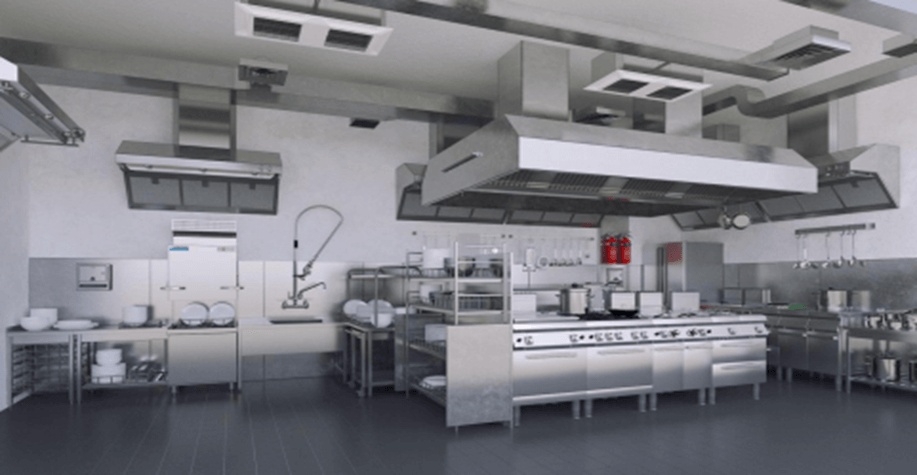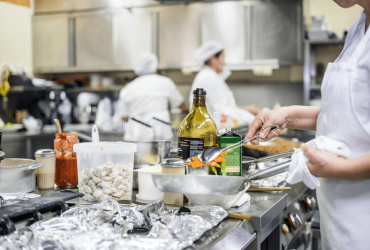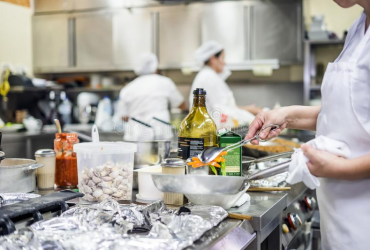Five Things You Need To Know About Commercial Interior Designing Today
Whether you plan on opening a brand new restaurant, or refurbish an existing one, planning a well-functioning commercial kitchen is the most tedious task in the restaurant business. It is understandable that you may not know where to start and we are here to help you with exactly that.

It is important to understand that no two commercial kitchens are alike. There are always different strategies involved in designing different kitchens based on the menu, the space available and various other underlying factors. However, there are certain fundamental steps that need to be considered while embarking the journey to a perfect design. Then, with the right interior design, all the factors are worked together for a seamless flow of work.
Listed below are some of the most crucial steps to be taken into account while designing a commercial kitchen-
- Menu
and equipments - Optimised
layout, light and ventilation - Easy
maintenance - Energy
efficiency - Local
codes and safety regulations
Menu and equipments
The first and foremost thing that must be decided is the menu. It is what the whole planning of the kitchen revolves around. There are various areas and equipment in the kitchen that need to be planned based on the preps and storage of the ingredients required for the menu.
The work surfaces, the storage shelves and all the elements in a commercial kitchen
equipments should be made of materials which are smooth, continuous, suitable for contact with food,
easily washable and disinfect-able. All the equipment that need to be facilitated should be placed in such a way that efficient work flow and good hygiene is maintained.

Optimised layout
While planning a commercial kitchen layout it is important to take into account the available space, proper light and ventilation. All of these factors work hand in hand to make a well-functioning kitchen. Always keep in mind to purchase or fabricate the equipment according to the dimensions suitable for the space available for your kitchen.
There are various arrangements that can be considered while designing your restaurant kitchen, for example, centre island, assembly line, open kitchen, etc. Sometimes you need to work out your own unique arrangement that works according to your spatial requirements. Taking measurements before you begin designing will make it easier in the long run. Keep in mind that it’s not just square footage. Knowing where windows, doors and electrical outlets are is also important, especially when it comes time to design your kitchen’s workflow. Every single space in your kitchen should be utilised accurately.
Moreover, the most important people that you need to treat well in your restaurant is your staff. They work day in and day out in the kitchen to make the restaurant a success. So it is obligatory to take care of their health and wellness. There are various kinds of emissions that are produced in a restaurant kitchen like smoke, fumes, etc. which demand an efficient light and ventilation system to ensure healthy working conditions and safety of your kitchen, staff, as well as customers.

Easy maintenance
Planning your kitchen based on easy maintenance is always a good idea. When it comes to commercial kitchens, maintenance should always be prioritised over alluring looks. Maintenance of a commercial kitchen takes a lot of time and effort. It is advisable to choose ways to reduce the efforts by choosing better options when it comes to cabinets, cookware storage, high quality and low maintenance material for various kitchen equipment.
Various areas should be segregated based on their functionality and usage, for example, the dishwashing area should be separated from the area where electrical appliances are placed. Wastage area should be easily accessible. Planning ahead for low maintenance in your commercial kitchen interior design can reduce the workload multifold in the long run.

Energy efficiency
The benefits of an energy-efficient design extend beyond the social and environmental advantages of reducing your carbon footprint. Although the major share of energy consumption comes from the use of heavy electrical equipment and systems, a careful arrangement of space may help in reducing its effects.
Moreover, energy efficiency is not just electrical. Reducing your water consumption , waste management, etc. have a role to play as well. Some of the ways you can be energy efficient in your commercial kitchen interiors is by using energy-efficient lighting, shutting down idle equipment, planning an efficient kitchen layout, performing equipment maintenance from time to time, and training your staff to follow energy-efficient protocols.
Local codes and safety regulations
Overlooking safety considerations is the most common mistake that people usually make while planning their commercial kitchen interiors. It is however the most important decision to make to avoid any hazards in the future. You can design the most configured kitchen space, but if you do not take local safety codes and regulations into account, it would all be in vain.
There are certain sets of rules and regulations from various food and safety departments regarding the storage, preparation, disposal, energy consumption, fire fighting, etc. which should always be incorporated in the design of your commercial kitchen for the safety of your own self, your staff and the customers. These codes may vary according to time and place, so it is advisable to do your homework before taking the plunge into the commercial kitchen design.
Conclusion
The possibilities of a restaurant business thriving increase quite a lot if you plan an efficient kitchen design. However, it is only human to not know how to go about it, and that is exactly why there are professionals to help you make your dream come true. Even if you have a clear vision about your restaurant, commercial kitchen design can be a challenging task, and hiring interior designers who specialise in restaurant interiors can help you achieve your goal while minimising the possibilities of things going wrong.



 Back to Blogs
Back to Blogs

 Prev
Prev

